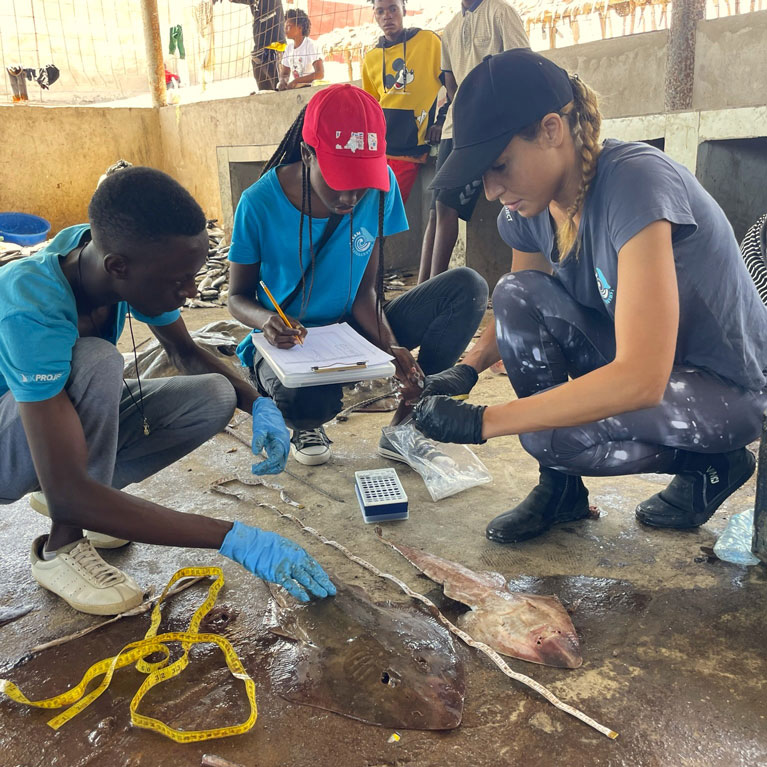The Angola Elasmo Project
Angola’s elasmobranchs (sharks and rays) are in big trouble. With intense pressure from coastal and offshore fisheries, their populations have been in decline since the demand for fins emerged in the 1970s and the country’s decades-long civil war. Ana wants to create long-term engagement in the country, gathering a plethora of information from biological samples to fisheries catch data, understanding national and international trade and reducing threats to sharks and rays. The goal is to secure the future for sharks and rays, and the communities that rely on them.
If I had to define myself in a word, I would choose ‘thalassophile’, a lover of the sea. Born and raised in a seaside town in Portugal, I was lucky to be in direct contact with the sea and I became fascinated by the marine ecosystem at a very early age. Understanding the sea and its organisms has always been my dream. During my studies – earning a Bachelor’s in marine sciences and a Master’s in marine biodiversity and conservation – I conducted research in various fields of marine science around the globe, including in Brazil, France, Portugal...
Elasmobranchs of Angola: Assessing impacts of small-scale fisheries on sharks and rays
To increase knowledge about sharks and rays along the coast of Angola and understand threats to them by providing baseline information on species diversity. The data collected will be key for the adequate monitoring of threatened populations and the development of effective management and conservation plans for Angolan waters.
Angola qualifies as an important area in West Africa for assessing the impact of small-scale and semi-industrial fisheries on shark and ray populations because of the evidence of serious threats from intensive coastal and offshore fishing and the limited information about the composition, abundance and distribution of species. This research and conservation project represents the first attempt to assess the status of sharks and rays in Angola and their
Data on elasmobranchs in Angolan waters are limited, although studies have been undertaken in other parts of western Africa. They reveal that, as a response to the increased demand for shark fins in Asian countries, West African shark and ray populations have declined sharply since the 1970s because an export market was established in The Gambia and subsequently in the rest of the SRFC zone (Cape Verde, Guinea, Guinea-Bissau, Mauritania, Senegal and Sierra Leone). Similar studies have not been conducted in Angola, however. Furthermore, the civil war in the country (1975–2002) led to an increase in fishing firstly because many people were displaced from rural to urban and coastal zones, as they offered greater security and the opportunity to work as fishers; and secondly because the socio-economic instability encouraged the activities of foreign and unsustainable fishing fleets.
The Angola Elasmo Project aims to increase knowledge about sharks and rays in Angola. Providing baseline information and collecting long-term scientific data about individual species will help us to understand the biodiversity of elasmobranchs. These data will be essential for the adequate monitoring of endangered populations and the development of effective management plans for West African waters. The small-scale and semi-industrial elasmobranch fisheries in Angola are likely to be unsustainable, as some of the species we have seen landed are listed as Endangered and Critically Endangered and are included on CITES Appendix II.
Getting local communities involved and creating awareness about threats to elasmobranchs are key factors in achieving positive conservation outcomes. By basing the project on a friendly, respectful relationship with fishers and local communities, we have been able to collect valuable data. In a communal effort, these data will be used to inform conservation policy and to initiate changes in perspective to reduce fishing pressure on threatened elasmobranch species.
The project was initiated to establish long-term engagement. The goal is to create a sustainable and lasting infrastructure that will contribute to the conservation of sharks and rays in the region while involving local communities and improving their livelihoods.
- To identify and describe small-scale fisheries operating along the coast (in terms of gear used, catch locations and fishery targets).
- To gather historical information and current insights into the status of shark fisheries so as to understand the nature of the interactions between fishers and sharks.
- To collect biological data (morphological identification, size and sex ratios) from shark and ray landings to assess the abundance and diversity of species.
- To identify and characterise the national and international trade of elasmobranchs by understanding the distribution chain of the products and their value and destination.
- To reduce the threats to sharks and rays at local and regional levels by building capacity and involving communities, and by developing educational and awareness materials that can be used in schools and by academics and fishery communities.
- To reflect on the prospects and trends of Angolan fisheries and consider management and conservation measures that could be implemented.


